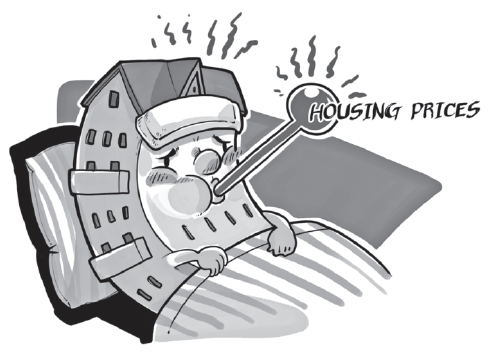 |
| CAI MENG/CHINA DAILY |
Real-estate prices in China's top cities are spiking, generating contradictory predictions of either a bursting bubble or a coming economic turnaround. What's really going on in China's property markets?
The National Bureau of Statistics revealed recently that 10 of the 70 large and medium-sized cities surveyed had recorded annual price increases of more than 20 percent for newly built commercial housing. In the first-tier cities of Shanghai and Shenzhen, those gains were even higher: above 37 percent. In the second-tier cities of Xiamen and Hefei, they exceeded 40 percent.
In 42 of the cities surveyed-those with industrial overcapacity and excessive property inventories-price increases amounted to less than 5 percent, with eight cities recording falling or stagnant property prices. This pattern of divergence creates a dilemma for Chinese policymakers and investors, who now must weigh carefully the insights of two economic giants: John Maynard Keynes and Friedrich Hayek.
At a time of slowing economic growth, some are advocating more Keynesian macro-stabilization measures, much like those China used to sustain growth after the global financial crisis of 2008. But in many areas, particularly in the northeast, central, and western parts of the country, the slowdown cannot be resolved through more stimulus.
In fact, stimulus in those regions would largely flow out, along with the labor and capital that is already being propelled toward coastal areas, which boast more advanced technology, higher rates of innovation, superior infrastructure and a more market-friendly business environment. What slower-growth regions need, therefore, is time to carry out supply-side structural reforms, including cutting inventories, reducing overcapacity and writing off the bad debts of local governments and State-owned enterprises.
The regions with surging property prices tend to be the ones that are drawing labor and capital with high growth and superior job opportunities. A study by China Securities International showed that, in 2000-10, cities in eastern China received 82.4 percent of total migrant inflows. By 2010, the migrant population in Beijing, Shanghai and Tianjin had more than doubled, to 34.5 percent, 37.9 percent and 21 percent.
In an attempt to manage the growth of these cities, which faced a huge shortage of land, housing inventories and urban public infrastructure, the governments imposed restrictions on both demand for and supply of housing. But, as the spike in housing prices in these cities shows, their efforts didn't work.
Policymakers had forgotten about Hayek. China's policymakers inadvertently created bottlenecks in local land supply. Residential land transactions in first- and second-tier Chinese cities remain thin and heavily influenced by urban planning policies, despite the depth and sophistication of residential property markets.
Fortunately, there is scope for China's urban planners to relax restrictions on the supply of land and on the floor area ratio (the ratio of gross floor area to the size of the lot on which the building stands). According to a China International Capital Corp study, the urban built-up area in Shanghai is only 16 percent, compared to 44 percent in Tokyo and 60 percent in New York City. Within that area, only 36 percent is used for residential functions in Shanghai, compared to 60 percent in Tokyo and 44 percent in New York City.
In other words, the available residential land for sale in Shanghai is considerably smaller than that available in New York City or even Tokyo, which is a major reason for surging property prices in these cities. In fact, if the supply of land and usable floor area is not increased, more spending on local public infrastructure will cause prices of existing space to rise even higher.
If the government ignores market price signals, mismatches between supply and demand could build up, undermining growth in dynamic regions, while leaving low-growth regions weighed down by excess capacity and bad assets.
The good news is that there is still considerable room for policy maneuver. The question now is whether the Chinese authorities will recognize and respond effectively to market signals.
Andrew Sheng is a distinguished fellow of the Asia Global Institute at the University of Hong Kong and a member of the UNEP Advisory Council on Sustainable Finance, and Xiao Geng, director of the IFF Institute, is a professor at the University of Hong Kong and a fellow at its Asia Global Institute. Project Syndicate